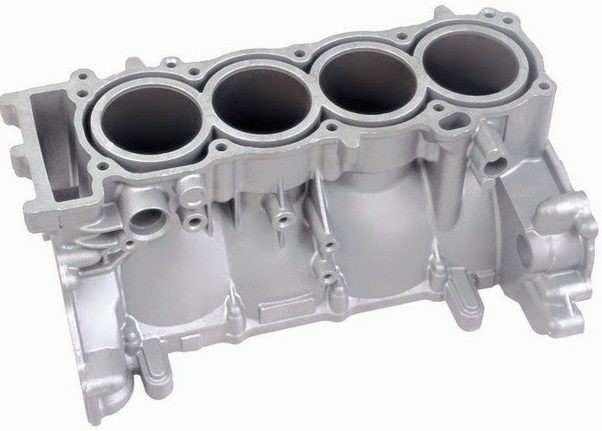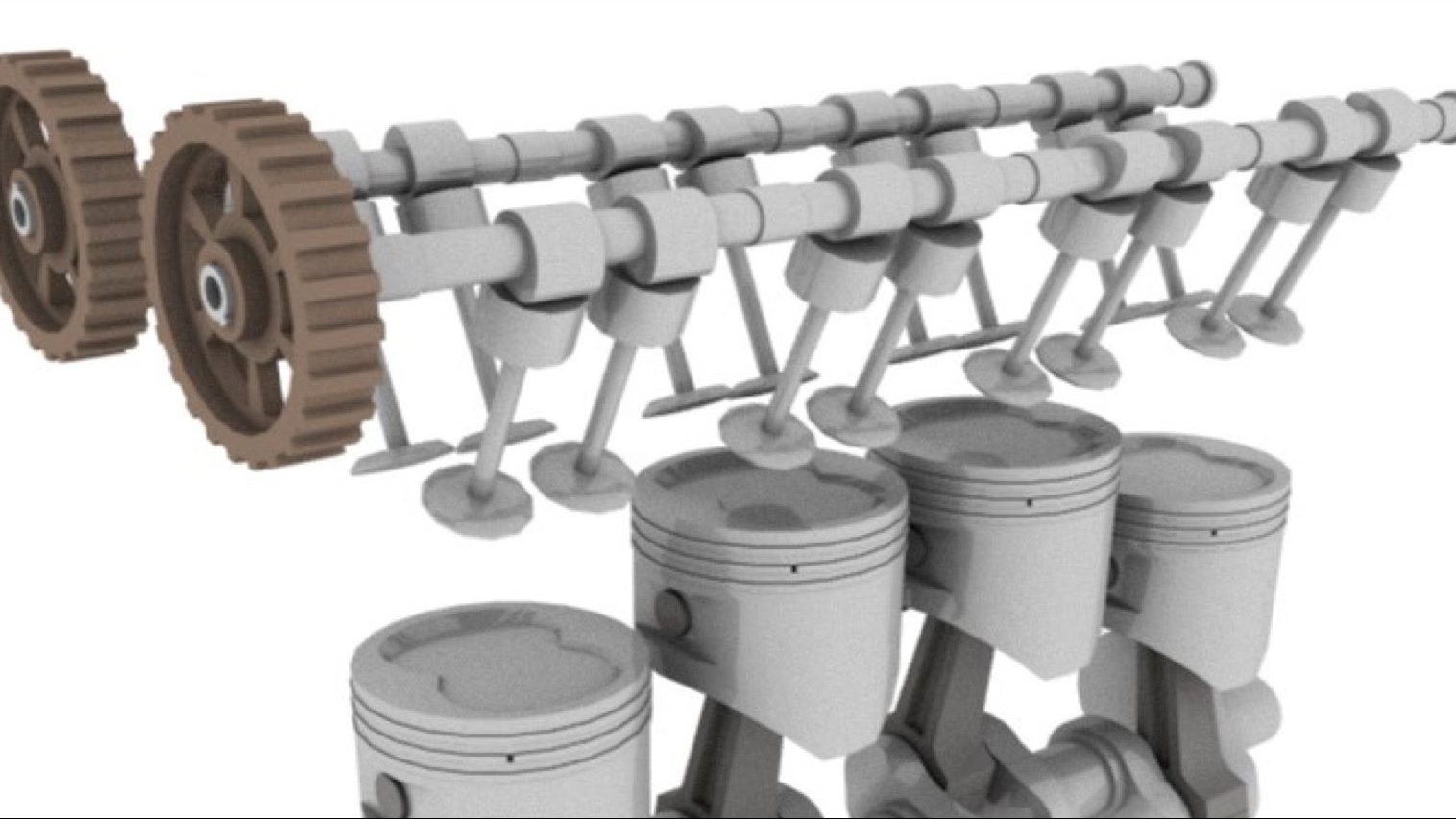The following are the main components found in most reciprocating IC engines:-
 |
| Cross-section of four-stroke cycle SI engine showing engine components |
A. Block
The body of the engine contains cylinders, made of cast iron or aluminum. In many older engines, the valves and valve ports were contained in the block. The block of water-cooled engines includes a water jacket cast around the cylinders. On air-cooled engines, the exterior surface of the block has a cooling fin.
Air & Water-cooled cylinder blocks
B. Camshaft
The rotating shaft is used to open valves at the proper time in the engine cycle, either directly or through mechanical or hydraulic linkage (push rods, rocker arms, tappets). Most modern automobile engines have one or more camshafts mounted in the engine head (overhead cam). Most older engines had camshafts in the crankcase. Camshafts are generally made of forged steel or cast iron and are driven off the crankshaft using a belt or chain (timing chain).
Pushrod type & Overhead type Camshaft
C. Combustion chamber
This is the area between the cylinder head and the piston face where combustion occurs. The size of the combustion chamber continuously changes from a minimum to a maximum from TDC to BDC.
D. Connecting rod
Rod connecting the piston with the rotating crankshaft, usually made of steel or alloy forging in most engines but may be aluminum in some small engines.
 |
| Connecting Rod |
E. Crankcase
This is a part of the engine block surrounding the rotating crankshaft. In many engines, the oil pan makes up part of the crankcase housing.
F. Crankshaft
Rotating shaft through which engine work output is supplied to external systems. The crankshaft is connected to the engine block with the main bearings. It is rotated by the reciprocating pistons through connecting rods connected to the crankshaft, offset from the axis of rotation. This offset is sometimes called crank throw or crank radius. Most crankshafts are made of forged steel, while some are made of cast iron.
 |
| Camshaft Parts |
G. Cylinders
The circular cylinders in the engine block in which the piston reciprocates up and down. The walls of the cylinder have highly polished hard surfaces. Cylinders may be machined directly in the engine block, or a hard metal (drawn steel) sleeve may be pressed into the softer metal block. Sleeves may be dry sleeves, which do not contact the liquid in the water jacket, or wet sleeves, which form part of the water jacket. In a few engines, the cylinder walls are given a knurled surface to help hold a lubricant film on the walls. In some very rare cases, the cross-section of the cylinder is not round.

H. Exhaust manifold
This is the piping system, which carries exhaust gases away from the engine cylinders, usually made of cast iron.
I. Head
The piece which closes the end of the cylinders, usually containing part of the clearance volume of the combustion chamber. The head is usually cast iron or aluminum, and bolts to the engine block. In some less common engines, the head is one piece with the block. The head contains the spark plugs in SI engines and the fuel injectors in CI engines and some SI engines. Most modern engines have the valves in the head, and many have the camshaft(s) positioned there also (overhead valves and overhead cam).
 |
| Engine Head & parts |
J. Intake manifold
This is a piping system that delivers incoming air to the cylinders, usually made of cast metal, plastic, or composite material. In most SI engines, fuel is added to the air in the intake manifold system either by fuel injectors or with a carburetor. Some intake manifolds are heated to enhance fuel evaporation. The individual pipe to a single cylinder is called a runner.
 |
| Intake Manifold Parts |
K. Oil pan
The oil reservoir is usually bolted to the bottom of the engine block, making up part of the crankcase. Acts as the oil sump for most engines.
 |
| Oil Pan of Car |
L. Piston
The cylindrical-shaped mass reciprocates up and down in the cylinder, transmitting the pressure forces in the combustion chamber to the rotating crankshaft. The top of the piston is called the crown and the sides are called the skirt. The face on the crown makes up one wall of the combustion chamber and may have a flat or highly contoured surface. Some pistons contain an indented bowl in the crown, which makes up a large percentage of the clearance volume. Pistons are made of cast iron, steel, or aluminum. Iron and steel pistons can have sharper corners because of their higher strength. They also have lower thermal expansion, which allows for tighter tolerances and less crevice volume. Aluminum pistons are lighter and have less mass inertia. Sometimes synthetic or composite materials are used for the body of the piston, with only the crown made of metal. Some pistons have a ceramic coating on the face.
M. Piston Rings
Piston rings are metal rings that fit into circumferential grooves around the piston and form a sliding surface against the cylinder walls. Near the top of the piston are usually two or more compression rings made of highly polished hard chrome steel. The purpose of these is to form a seal between the piston and cylinder walls and to restrict the high-pressure gases in the combustion chamber from leaking past the piston into the crankcase (blowby). Below the compression rings on the piston is at least one oil ring, which assists in lubricating the cylinder walls and scrapes away excess oil to reduce oil consumption.
 |
| Piston Rings with Configuration |
N. Pushrods
These are mechanical linkages between the camshaft and valves, on overhead valve engines with the camshaft in the crankcase. Many push rods have oil passages through their length as part of a pressurized lubrication system.
 |
| Push Rod Linkage |
O. Spark Plug
This one is an electrical device used to initiate combustion in an SI engine by creating a high-voltage discharge across an electrode gap. Spark plugs are usually made of metal surrounded by ceramic insulation. Some modern spark plugs have built-in pressure sensors that supply one of the inputs into engine control.
 |
| Spark Plug |
P. Valves
Valves are used to allow flow into and out of the cylinder at the proper time in the cycle. Most engines use poppet valves, which are spring-loaded closed, and pushed open by camshaft action. Valves are mostly made of forged steel. Surfaces against which valves close are called valve seats and are made of hardened steel or ceramic. Rotary valves and sleeve valves are sometimes used but are much less common. Many two-stroke cycle engines have ports on the side of the cylinder walls instead of mechanical valves.
 |
| The valve of the IC Engine |
Q. Water Jacket
Water jackets are the passages surrounding the cylinders, usually constructed as part of the engine block and head. Engine coolant flows through the water jacket and keeps the cylinder walls from overheating. The coolant is usually a water-ethylene glycol mixture.
- See other components of the Engine - HERE
References:
1. Engineering Fundamentals of IC Engine - Willard W. Pulkrabek
2. Click on the images to see image references
3. http://www.substech.com/dokuwiki/doku.php?id=bearings_in_internal_combustion_engines
4. wikipedia.com

















